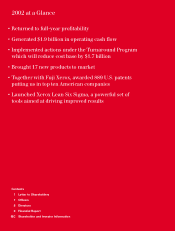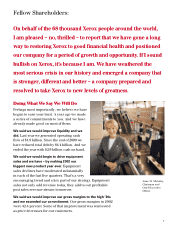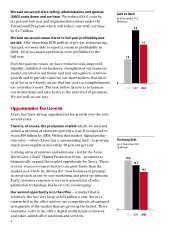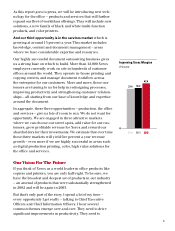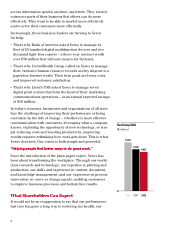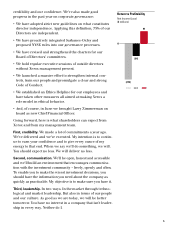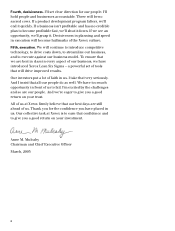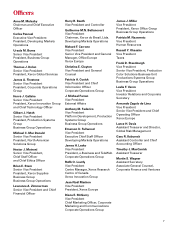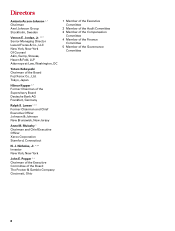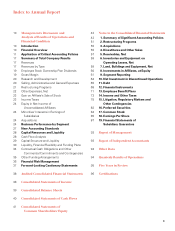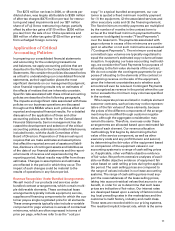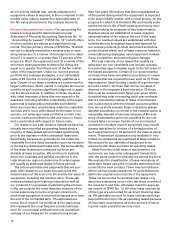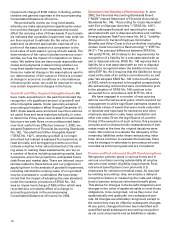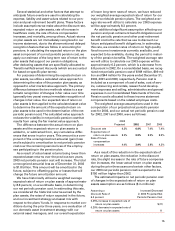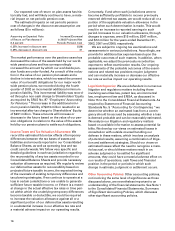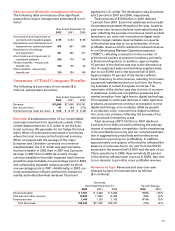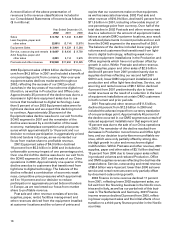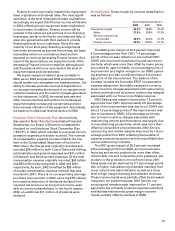Xerox 2002 Annual Report Download - page 12
Download and view the complete annual report
Please find page 12 of the 2002 Xerox annual report below. You can navigate through the pages in the report by either clicking on the pages listed below, or by using the keyword search tool below to find specific information within the annual report.
10
Throughout this document, references to “we,” “our”
or “us” refer to Xerox Corporation and its subsidiaries.
Introduction:
This Management’s Discussion and Analysis of
Results of Operations and Financial Condition
(“MD&A”) describes the matters that we consider to
be important to understanding the results of our
operations for each of the three years in the period
ended December 31, 2002 and our capital resources
and liquidity as of December 31, 2002 and 2001. Our
discussion begins with an overview of our financial
performance for the last three years and is followed
by a review of the critical accounting judgments and
estimates that we have made which we believe are
most important to an understanding of our MD&A
and our consolidated financial statements. These are
the critical accounting policies that affect the recogni-
tion and measurement of our transactions and the
balances in our consolidated financial statements. We
then analyze the results of our operations for the last
three years, including the trends in the overall busi-
ness and our operating segments, followed by brief
reference to where you can find more information on
recent accounting pronouncements which we adopt-
ed during the year, as well as those not yet adopted
that are expected to have an impact on our financial
accounting practices. We conclude our MD&A with a
discussion of our cash flows and liquidity, capital mar-
kets events and transactions, credit ratings, our new
credit facility, derivatives, contractual commitments
and related issues and important forward-looking
cautionary statements.
Financial Overview:
In 2002, we returned to profitability, significantly
strengthened our balance sheet and launched 17 new
products, making the year one of our strongest ever
for new products. Our results demonstrate effective
execution to date of our Turnaround Program, which
we announced in October 2000. Our Turnaround
Program has focused on improving liquidity, stabiliz-
ing our operations and significantly reducing our cost
base in order to improve our competitiveness. By the
end of 2002, we had sold assets totaling approximate-
ly $2.7 billion, implemented actions to reduce our
annualized costs by approximately $1.7 billion and
returned each of our core business segments to prof-
itability. During this period we also transitioned a por-
tion of our equipment financing to third parties in
Management’s Discussion and Analysis of
Results of Operations and Financial Condition
some geographies and implemented a strategy to
securitize our finance receivables.
Throughout 2002, the worldwide economic envi-
ronment and information technology spending
remained weak, however, our equipment sales and
revenue declines moderated, reflecting the success of
our new products launched during the year. Improved
gross margins and reduced selling, administrative
and general expenses, reflect benefits from our cost
base reductions, our focus on more profitable rev-
enue and our exit from certain businesses. While we
reduced our overall cost base, we continued to invest
in research and development, prioritizing our invest-
ments in the faster growing areas of our market. We
strengthened our balance sheet and liquidity by gen-
erating operating cash flows of $1.9 billion, repaying
debt of $3.2 billion, negotiating a new credit facility
and securitizing almost half our finance receivables
by the end of 2002.
Net income for 2002 of $91 million, or 2 cents per
diluted share, included after-tax asset impairment and
restructuring charges of $471 million ($670 million
pre-tax), primarily associated with our Fourth Quarter
2002 Restructuring Program, a pre-tax and after-tax
charge of $63 million for impaired goodwill and an
after-tax charge of $72 million ($106 million pre-tax)
for permanently impaired internal-use capitalized
software, partially offset by $105 million of tax bene-
fits arising from the favorable resolution of a foreign
tax audit and tax law changes, as well as a favorable
adjustment to compensation expense of $31 million
($33 million pre-tax), that was previously accrued in
2001, associated with the reinstatement of dividends
for our Employee Stock Ownership Plan (“ESOP”).
The 2001 net loss of $94 million, or 15 cents per
diluted share, included $507 million of after-tax
charges ($715 million pre-tax) for restructuring and
asset impairments associated with our Turnaround
Program including our disengagement from our
worldwide Small Office/Home Office (“SOHO”) busi-
ness. 2001 results also included a $304 million after-tax
gain ($773 million pre-tax) from the sale of half of our
interest in Fuji Xerox, a $38 million after-tax gain
($63 million pre-tax) related to the early retirement of
debt, $21 million of after-tax gains ($29 million pre-tax)
associated with unhedged foreign currency, partially
offset by $31 million ($33 million pre-tax) of increased
compensation expense associated with the suspen-
sion of dividends for our ESOP and after-tax goodwill
amortization of $59 million ($63 million pre-tax).


